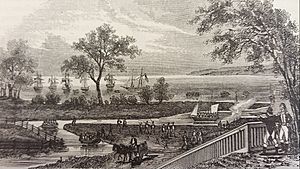Battle of Buffalo facts for kids
Quick facts for kids Battle of Buffalo |
|||||||
|---|---|---|---|---|---|---|---|
| Part of War of 1812 | |||||||
 The port of Buffalo prior to the battle in 1813 |
|||||||
|
|||||||
| Belligerents | |||||||
| Commanders and leaders | |||||||
| Strength | |||||||
| 965 British regulars 50 Canadian militia 400 Natives |
2,011 | ||||||
| Casualties and losses | |||||||
| 31 killed 72 wounded 5 captured 4 missing |
50 killed 52 wounded 11 wounded prisoners 56 captured |
||||||
The Battle of Buffalo (also called the Battle of Black Rock) happened during the War of 1812. It took place on December 30, 1813, in New York State, near the Niagara River. British forces attacked and defeated American defenders. They destroyed many buildings and ships in the area. This attack was a response to American troops burning the Canadian village of Newark.
Contents
Why Did the Battle of Buffalo Happen?
The battle was part of a larger conflict called the War of 1812. It was a war between the United States and Great Britain. The fighting often happened along the border between the U.S. and Canada.
The Burning of Newark
In December 1813, an American general named George McClure was in charge of Fort George in Canada. He decided to leave the fort. Before leaving, he ordered the nearby village of Newark to be burned down.
The people living in Newark were given only a few hours' notice. They were forced out into the cold winter night. Almost all of the 150 buildings in the village were destroyed by fire. This act made the British very angry.
British Response and Raids
After Newark was burned, Lieutenant General Gordon Drummond took charge of the British forces in Canada. He planned to attack American positions. On December 18, a British force captured Fort Niagara by surprise.
Another British force, led by Major General Phineas Riall, raided the American side of the Niagara River. They destroyed several villages, including Lewiston and Youngstown. Riall's raid stopped when Americans burned a bridge over the Tonawanda Creek.
Drummond and Riall wanted to cause more damage. Riall's troops moved south to attack the villages of Buffalo and Black Rock.
Who Fought in the Battle?
Major General Riall led the British side. His force included about 1,415 soldiers. These were British regulars, Canadian militia, and Native American warriors.
The American side was led by Major General Amos Hall. He had about 2,011 men. These were mostly volunteers and militia from New York. They were stationed in Buffalo and Black Rock.
How Did the Battle Unfold?
Riall's troops crossed the Niagara River around midnight on December 29. They landed near Black Rock in the early hours of December 30. Part of his force attacked Black Rock directly.
Major General Hall learned of the British attack when the British drove away American guards. Hall sent out troops to check, but they ran away when the British fired. Hall then took command himself.
Fighting at Black Rock
As the sun rose, Hall's men fired heavily at the British trying to land at Black Rock. The British faced strong resistance and took many casualties. But they managed to force their way ashore.
Riall then moved his main force against Hall's center. He also sent a group to attack the American right side. The Americans fought hard, but after about 30 minutes, their right side broke and ran.
Hall ordered a full retreat to avoid being surrounded. The British chased them for two miles, all the way to Buffalo.
Destruction of Buffalo and Black Rock
Once in Buffalo, the British and Native American allies looted the town. They burned almost all of its buildings. Only four buildings were left standing. The British also destroyed the navy yard and several American ships.
After Buffalo, Riall's force moved to Black Rock. There, they also burned almost every building to the ground. Then, they returned to Canada.
What Were the Losses?
The British reported 31 killed, 72 wounded, and 9 missing. Many of these losses were from the Royal Scots regiment, who faced heavy fire while landing.
The Americans reported 50 killed and 52 wounded. Lieutenant Colonel Boughton was among those killed. About 67 Americans were captured, including Lieutenant Colonel Chapin. The British also captured eight American cannons. Only one American civilian died during the battle.
What Happened After the Battle?
On January 22, 1814, the British Commander-in-Chief, Sir George Prevost, spoke about the battle. He said he regretted the "miseries inflicted upon the inhabitants of Newark." He explained that the destruction of Buffalo was a necessary response to that act.
Images for kids




